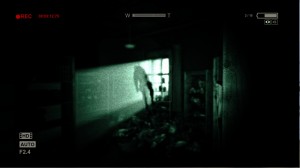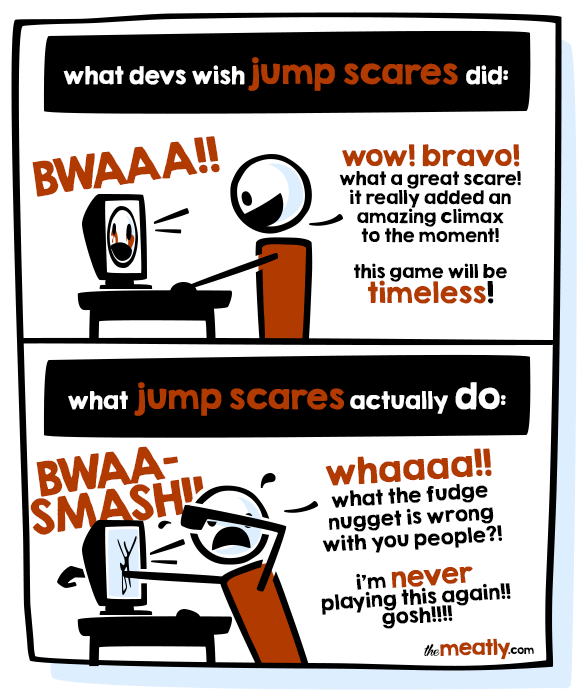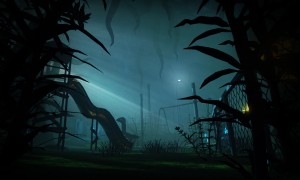The Challenge of Horror in Video Games
Posted by Rampant Coyote on October 6, 2014
In the Barnson household, we celebrate Halloween all month long. It’s all about scary. We value scary. My wife, who tells ghost stories professionally (yes, that is a thing), has a whole verbal essay about the value of these kinds of tales. From the purely cautionary roles, to catharsis, to simply exploring scary situations or emotions from a position of safety, there are many reasons these stories have flourished.
Are games any different?
Games take us “there” more than any other medium. They can theoretically combine the best of film and literature into an experience all of its own. And from my own perspective, games can be far scarier than any movie or book I’ve experienced. I knew this back in the early 90s, when I was hunting (and being hunted by) an invisible demon in the mazes of the original Doom, or when guiding my X-Com team through an abandoned farms, knowing that a move around a corner might bring instant death to a key team member, while the “music” throbbed and warbled in imitation of an accelerated heartbeat.
Games can do horror really, really well. However, there are problems. None of these are insurmountable – in recent years, we have had a ton of indie horror-themed games, some of which have been pretty outstanding. But the interactive medium of video games offer challenges not found in more linear, traditional mediums. And some of these cut straight into the nature of horror.
Control, interactivity, and powerlessness
 One of the major aspects of horror is a feeling of powerlessness – of loss of control (after a certain point), the horror of becoming a “victim.” Games are all about control. It’s called interactivity. When you have the ability to respond, react, and defeat the horror, it becomes more of an action game than a horror title. Sure, like any other action game, you may have scares and jumps, and you may be facing a foe (or combined foes) that you simply cannot permanently defeat. The zombies keep coming, the elder gods are only slowed down, whatever. But it doesn’t change the fact that we can eventually “win” – if only by escaping. But always – that’s under our control.
One of the major aspects of horror is a feeling of powerlessness – of loss of control (after a certain point), the horror of becoming a “victim.” Games are all about control. It’s called interactivity. When you have the ability to respond, react, and defeat the horror, it becomes more of an action game than a horror title. Sure, like any other action game, you may have scares and jumps, and you may be facing a foe (or combined foes) that you simply cannot permanently defeat. The zombies keep coming, the elder gods are only slowed down, whatever. But it doesn’t change the fact that we can eventually “win” – if only by escaping. But always – that’s under our control.
This is a problem across the board with stories in video games – the needs of dramatic storytelling are at odds with the needs of gameplay. The player, ever aware that they are in a game, do not make the kind of decisions that a good protagonist “should” the purpose of building the drama. Or they may simply not play according to the script – what I sometimes refer to as the “shoe tying problem:” Referencing the movie Jurassic Park, I often note that in a game, the player may be busy tying his shoe when the T-Rex makes her big reveal. It’s a lesser version of the same thing.
Game developers have worked around this problem by limiting interactivity – or simply taking control away from the player completely in some areas or during cut-scenes. I suppose that to a point, this has become accepted, part of the language of games. But whenever and however it happens – whether the player notes that his or her path is constrained by obstructions that make their navigation excessively linear, or that they lose control and are forced to react in a way contrary to their gamer instincts, the player is reminded that they are only in a game, and lose an element of immersion. Is the sacrifice worth it? Sometimes, yes, if done sparingly and subtley. Other times… not so much.
Death is boring
Another twist in the medium is that while video games may trigger our instinctive survival instincts to scare us, when the games do carry out the threat of offing our in-game persona, it reduces the terror. We “die,” and enjoy a release of tension. The worst has already happened – there’s nothing more that the game can throw at us. We respawn at the last checkpoint, and try something different, but the game no longer has as much power to frighten us. At least not for a while. It’s the equivalent of a linear medium “cheating” and saying that the previous scene was all a fake – a dream or a fantasy or something.
In linear media, a frequent approach is to shift points of view, and have the story kill off other characters. In this way, the deaths really do count, and the audience is informed of all the behaviors that lead to death: Cowardice, hubris, immorality, stupidity, whatever. Games have traditionally not employed this shift in perspective between different characters very often. Maybe that’s something we should experiment more with.
Jump scares are easy and overused
Then there’s “jump scares.” These are the cheap trick of traditional media, the equivalent of suddenly shouting “BOO!” at the audience while they are absorbed with rising tension. These are no less lame in games than they are in any other medium, and should be employed sparingly. The occasional cheap jump scare can serve as a temporary tension release, allowing an increase in tension to follow. Sadly, too many “scary” games depend almost exclusively on these. I think The Meatly offers a pretty good commentary on the overuse of this device:
 Numbers and Systems make the Unknowable Knowable
Numbers and Systems make the Unknowable Knowable
Ultimately, in a computer game, everything comes down to numbers – ones and zeros. Everything is quantified and run through a system. Even if the eldritch horrors of your game are unkillable and don’t have to worry about stats like hit points or armor, their behaviors and limitations have to be built into the game. Yes – limitations. Something has to prevent the horrible monster from teleporting through the wall and devouring the player the moment he presses the “Begin New Game” button.
And since they must be quantified within the system, perceptive players may figure it out. And since fear of the unknown remains the greatest fear of all, once the enemy becomes known and in any way quantified, it loses its terror. In extreme cases, it may even be subject to a bug, predictable pattern, or some other anomaly that can be exploited by the player.
 The Unsettling doesn’t bear up under careful observation
The Unsettling doesn’t bear up under careful observation
One of the best ways to build up tension and a feeling of horror is to have the audience encounter unsettling elements that are not of themselves threatening, but are perhaps indicators that the character is not safe: An off-key music box suddenly playing without being activated, a fresh bloodstain on the ceiling that begins to drip, the gruesome remains of a dead animal, a cold spot in the room, a record that plays music that the character has never heard before except inside his recurring nightmare. That’s great stuff. But within the mechanical simulation of a world, the player may be free to scrutinize these elements to the point that their inherent creepiness gets lost. Once again, the mechanical systems, repetitiveness of the animations, and scripted trigger points may become apparent, and lose some of their ability to thrill.
Tension fatigue
Games often offer a good deal more playing time than your average movie. Maybe even an order of magnitude. The thing is – horror is something that works best with a growing sense of tension. But it can’t grow forever. If it takes to0 long to get to the payoff, the player is going to suffer fatigue, lose interest, or simply become numb to it. Or worse, begin mocking it. In good storytelling, there are several points where the tension is momentarily relieved, and the audience is given the opportunity to relax a little bit before the next big build-up. This is true in games as well. But there’s only so many times the cycle can be repeated before it, too, loses its power. Games have to manage that without (usually) having strict control over the pacing – which is often in the hands of the player.
But scary games abound…
In spite of these challenges, scary and horror-themed games abound nowadays, particularly among the indies. Indies have proven willing to experiment – often out of necessity of limited budgets as anything else. But perhaps unsurprisingly, being forced by constraints to leave a bit to the imagination is what has allowed these kinds of games to succeed, and in many cases, kick butt.
Or at least kick my butt. I know that they’ve helped me come to realize that I’m a chicken. It’s embarrassing to admit, but yeah – I get my stress / terror threshold exceeded, and I have to take a break. I can’t completely override my survival instinct, and so I have to flee into the real world, I guess. It doesn’t happen so much with movies or books, but the right game can push my buttons.
Yet I keep coming back…
Now we have a wonderful breadth of horror-themed games, from horror-comedies about mowing down zombies, to “survival horror” titles where brute force is a necessity but of limited utility, to spine-tingling adventure games, to downright terrifying first-person thrillers. So – for much of this month, I’m going to talk about horror-themed indie games. Many will be familiar to veterans of indie gaming, but hopefully some will be new. Not all will be scary, but some… well, some are all but guaranteed to freak you out.
Happy Halloween, folks… 🙂
Filed Under: Design - Comments: Read the First Comment
Modran said,
Ok, I’m game. If worse comes to worse, I’ve got a friend who’s seriously addicted to this kind of stuff. I’ll hide behind her and giggle as she screams 🙂